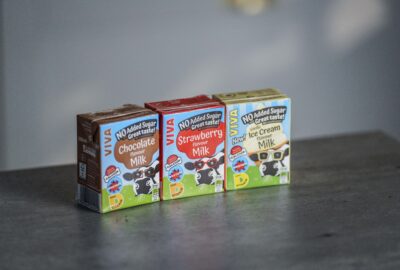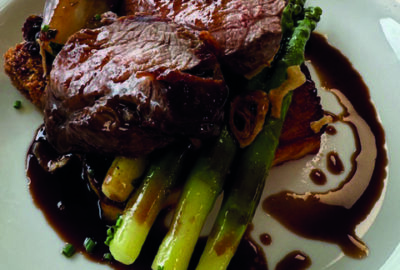Seafood of all kinds will continue to appear on menus over the next few years driven heavily by consumers’ increased focus on reducing meat consumption, not forgetting the well-known health benefits ticking a major box for customers across all sectors.
That said, consumers are increasingly concerned about sustainability and the environment, and this extends to their choices regarding seafood. Fish stocks are in a state of decline and, according to the Marine Conservation Society, 90% of the world’s fish stocks are fully or over-exploited from fishing. Climate change and pollution also play a role in declining stocks, but caterers are being urged to play their part and make responsible choices when creating their menus, and only serve fish from sustainably managed sources.
We asked the “new wave” of chefs to share their tips, ideas and recipe suggestions for dishes made with seafood on the Good Fish Guide.
Allan Kay head chef, Hare and Hounds, Levens, Cumbria-
I take pride in using sustainable ingredients from The Lakes and surrounding areas – it reduces food mileage, guaranteeing freshness. I make simple switches to contribute to helping both the environment and local economy. My Mediterranean pan-fried sea bass is a firm favourite, featuring sustainable in-land farmed fillets, protecting wild marine life. Pan-frying crisps the skin adding flavour and texture. I add smoky chorizo and cherry tomatoes for sweetness, lifting the dish with aromatic saffron mash. Fresh tenderstem broccoli adds colour and I finish it with a Mediterranean dressing of fresh oregano, roasted red peppers and tomatoes for a summery hit.
Nat Tallents chef patron of The Plume of Feathers in Mitchell, Cornwall
Using a sustainable fish feels like the more honest choice to offer our customers, in my opinion. Here at The Plume, I love working with hake –it’s abundant in Cornwall and a stunning, flaky white fish which pairs beautifully with heritage tomatoes and wild garlic from our kitchen garden. It doesn’t need too much cooking (when fresh, this is a very soft fish, so I’d urge you not to mess with it too much). Season and add a small amount of butter before grilling skin-side up for five minutes and finish off with four minutes in the oven at 180°C.
Craig Mather Michelin-trained executive head chef at Little Ships restaurant in Ramsgate in Kent
The art of cooking fish is simple: It needs to be treated delicately and not overcooked. I like to barbecue my fish using a locally engineered Harrison charcoal oven. It cooks quickly and at a very high temperature, which gives an amazing, smoky flavour, crisps the skin beautifully and keeps the fish succulent and juicy. We make a great Dukkah-crusted mackerel fillet served with tahini, sriracha, pickled cabbage, radish and diced tomatoes on a flatbread. We also cook fresh local lobsters in the Harrison oven, brushed with our secret recipe Café de Paris butter and served with salad, fries and citrus mayonnaise. Clams and mussels have a number 1 sustainability rating and we used those for classic moules marinieres and seafood linguine dishes.
Iain Jackson catering manager, Rougemont School, a private school in Newport, South Wales
Cod stocks are depleting so we serve lots of fresh hake, pollack and dab instead, plus it’s a lot cheaper. We are on a tight budget so we can work with these margins. Pollack is actually underfished. One of the dishes we serve is pan-friend pollack on a bed of minted peas and broad beans with sun-dried tomato pesto. Paella is another popular dish using local calamari, prawns and mussels, which means fewer food miles. Salmon is a popular choice with our pupils. We make salmon Wellington, using Country Range Frozen Puff Pastry Blocks, and Tandoori salmon with Thai noodles, using Country Range Medium Egg Noodles.
Ruth Hansom previous winner of Young National Chef of the Year, star of BBC Two’s Million Pound Menu, and head chef at Pomona, Notting Hill
Using sustainable fish is of huge importance to me. Scientists say that if we continue to use current practices, by 2048 we will no longer have edible fish in the sea! I do hope to be around by then so this worries me, not only for future generations but also my own. With this in mind, I source fish that has been caught sustainably and where possible from around the British Isles. The halibut we use on our menu is Gigha halibut, caught off the Scottish coast. The product is a result of 20 years of dedicated research and development. Work started on halibut at the marine hatchery at Otter Ferry on Loch Fyne in 1991 with the successful capture and transportation of live wild halibut from the North of Scotland, Iceland and the Faroe Islands. The challenge then was to work out the life cycle of the halibut and the optimum conditions for each stage. Wild halibut is now listed as an endangered species. Gigha halibut offers an alternative source of halibut which helps reduce the pressure on the endangered wild stocks of halibut in the sea. For the full recipe for Ruth’s Pan Roast Halibut, visit www.stiritupmagazine.co.uk/recipes.
Robert Weston head chef, Borrowdale Hotel, Cumbria
Mackerel is super tasty and full of omega-3 fatty acids, so is a great choice for healthconscious diners. A popular dish at our hotel is scorched mackerel fillets served on a bed of crushed Jersey Royal potatoes, served with cooked candy beet, confit cherry tomatoes and trimmed fine green beans. Drizzle with wild garlic oil for added flavour.
Nathan Outlaw owner and head chef of the two Michelin star seafood Restaurant Nathan Outlaw in Port Isaac, Cornwall
If we don’t buy fish and seafood sustainably there will come a day when it won’t be there to buy. My advice? Ask questions about what the fishermen are catching. You can track them via social media and internet
these days so there’s no excuse. Ask where they’ve been fishing, what they’re catching, how much and how they’re catching it. It’s the same rule at your fishmonger, if they can’t answer these questions, don’t buy
the fish. Sustainability guides are useful but what’s sustainable in one place may not be in another so ask the guys who catch it!
Awanish Roy the executive head chef of the awardwinning Saffron Summer fine dining Indian restaurant in Chessington
Cooking seafood is one of my passions and the smell of it when getting cooked – grilled, pan fried or in a curry – is just divine. Here are some of the general tips for cooking perfect fish:
- When cooking an Indian fish curry, bring the oil to its smoking point and add the ‘paanch phoran’ which are five spices – mustard seeds, fenugreek seeds, cumin seeds, fennel seeds and nigella seeds. This is a must-have spice in the fish curry that is cooked in Eastern India. Sauté the onions on a low heat and cook the fish covered so it retains maximum flavours and moisture.
- The fish should be as fresh as possible. When buying, one must ensure the eyes are clear, gills just below the head must be bright red and the scales shiny. The flesh should be translucent and resilient.
- No one likes bones in the fish so ask your fishmonger to fillet the fish away from the belly bones otherwise slide a filleting knife under each bone to remove.
- If you are grilling thick fish steaks, marinate them for 15 minutes in lemon or lime juice before cooking. The acid from the juice cooks the fish a bit, cutting down on the time it needs to stay on heat so the steaks are less likely to dry out.
- When frying a fillet of fish, dust the fish with seasoned flour (salt, pepper and spices), ensure to preheat the pan as it prevents the fish from sticking to the pan. A combination of oil and butter is desirable, the butter imparts a unique flavour and the oil prevents the butter from burning.
“Squid is in ample supply. It breeds prolifically, grows quickly and is probably the most sustainable of all fish stocks.”
For the full recipe, visit www.stiritupmgzine.co.uk/recipes.



